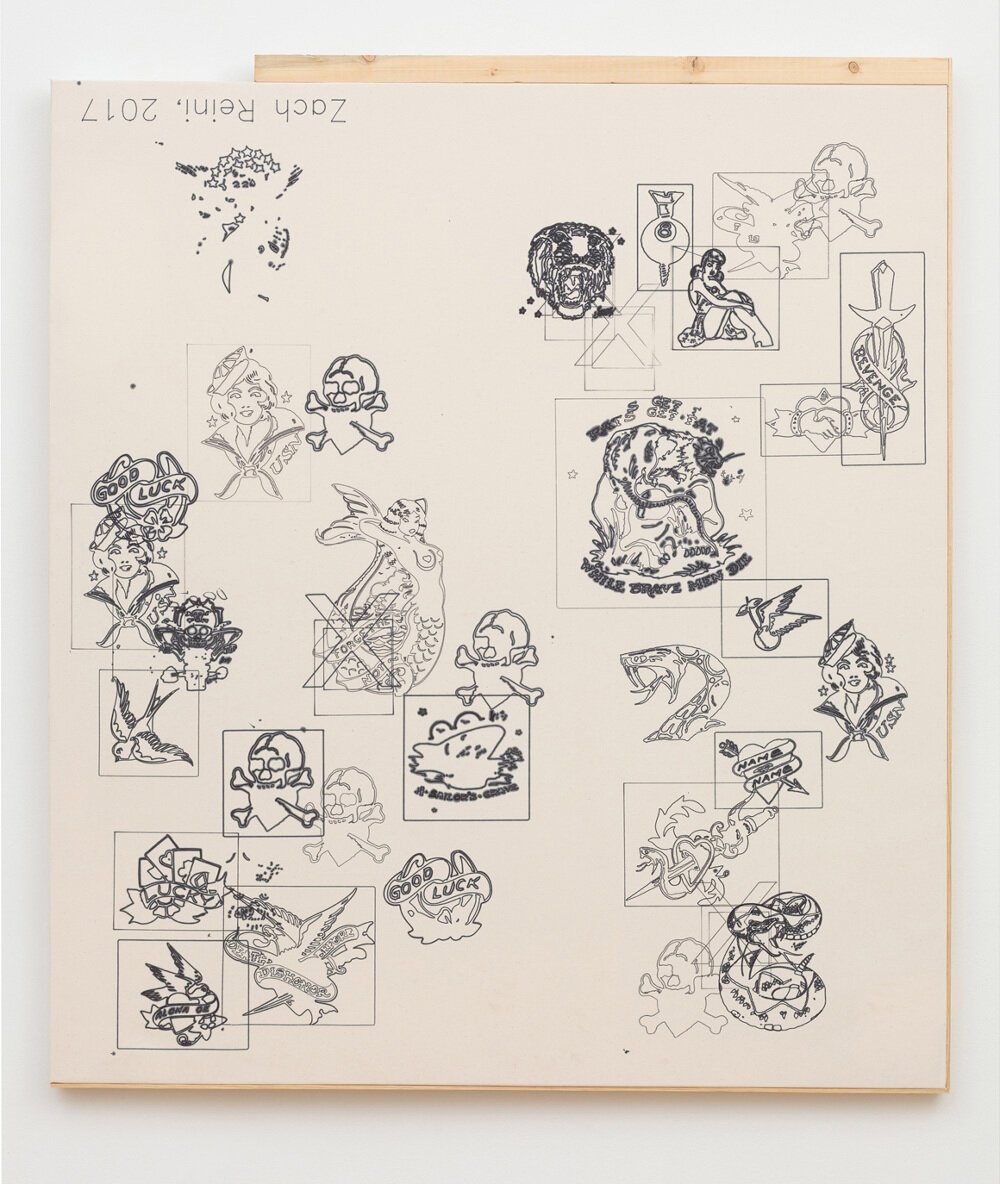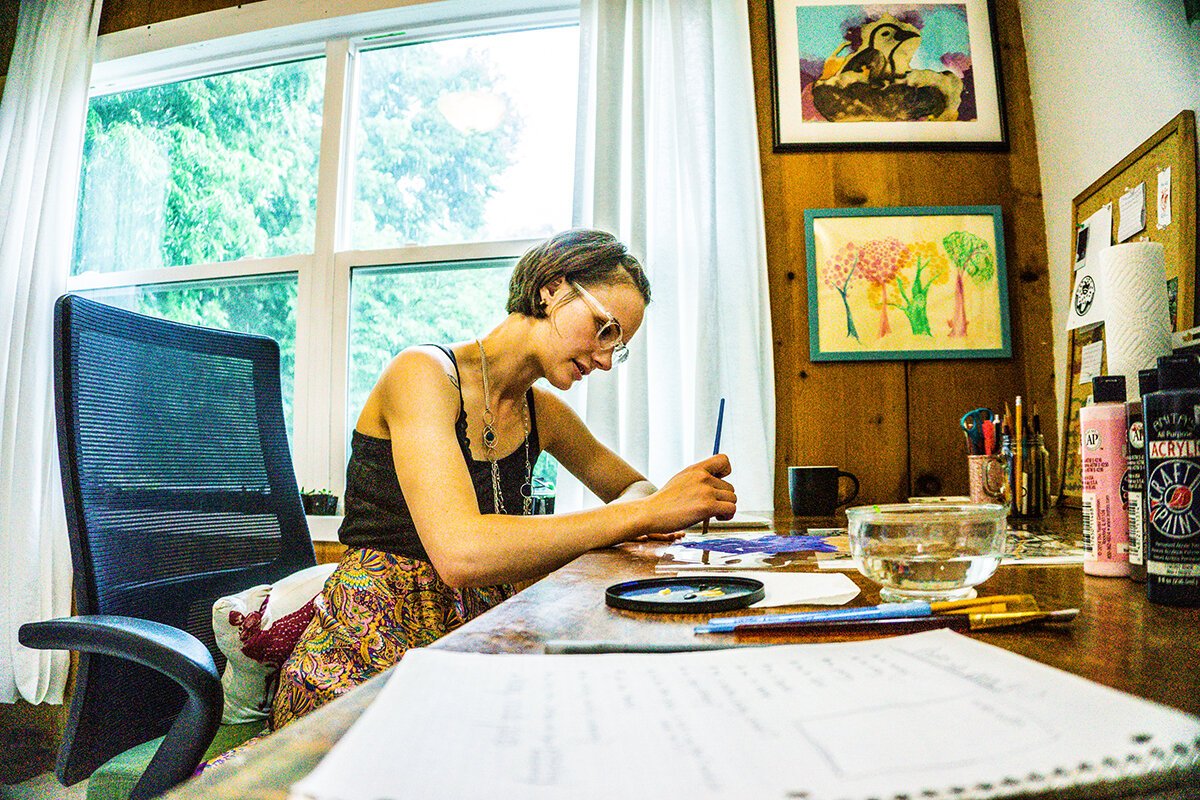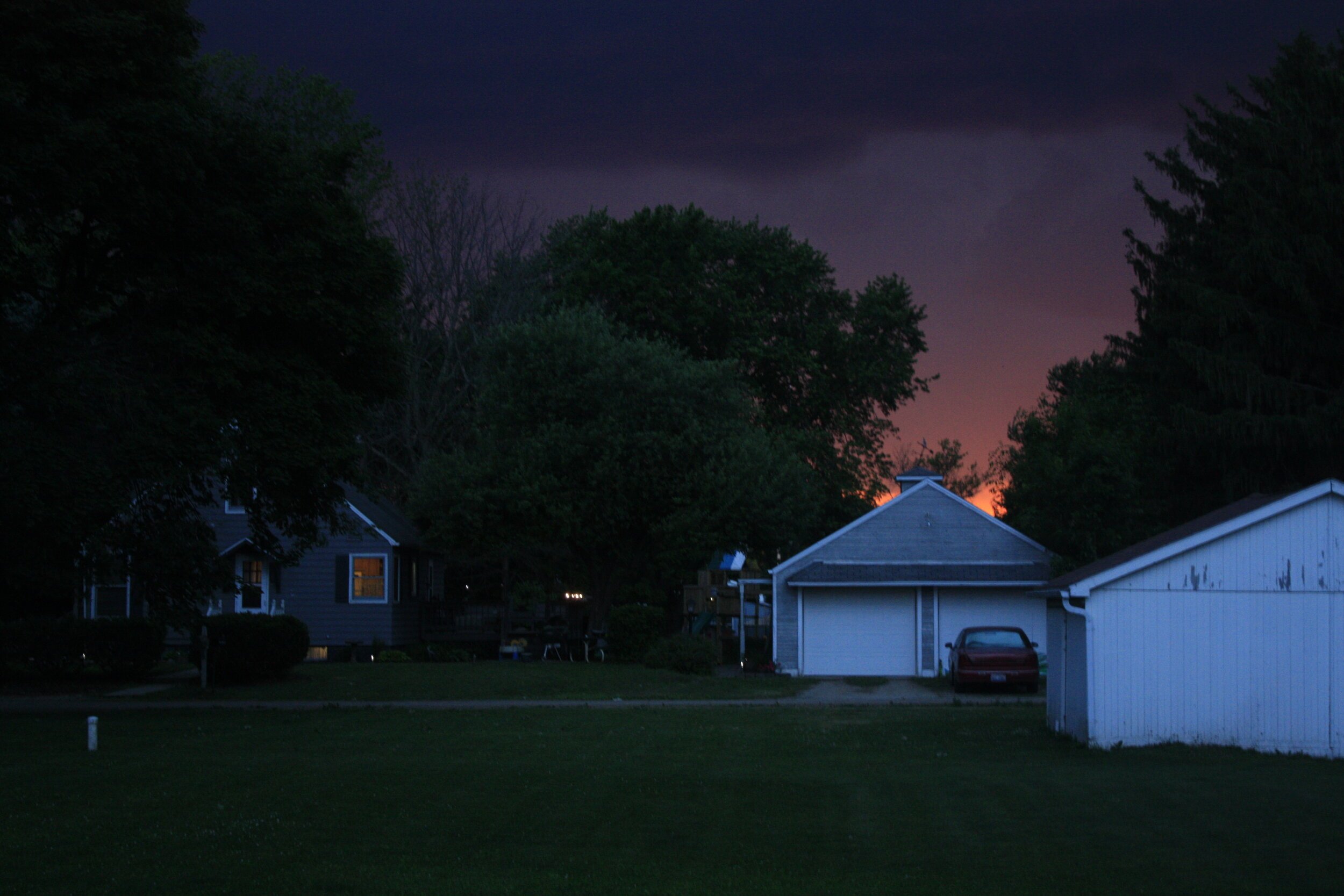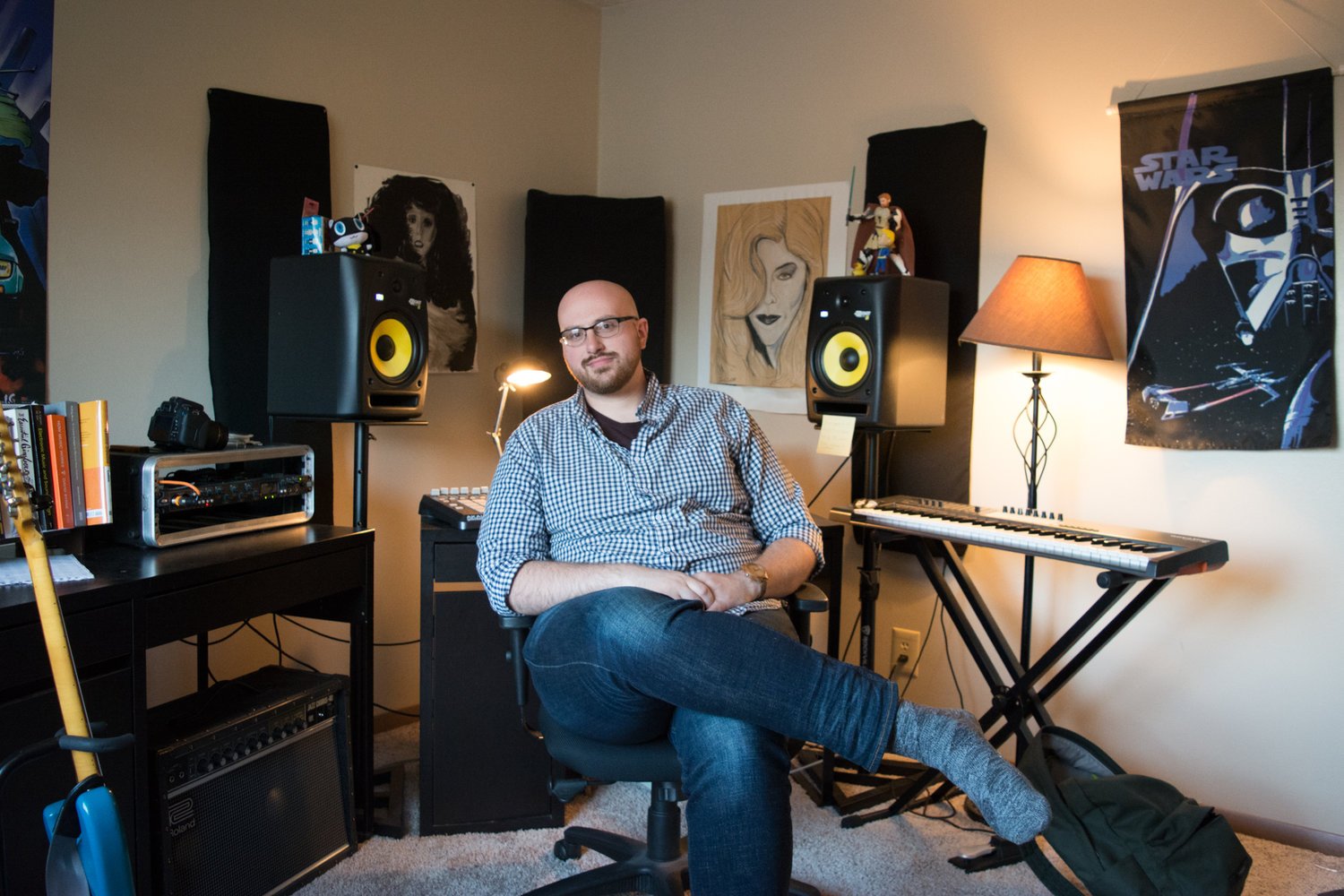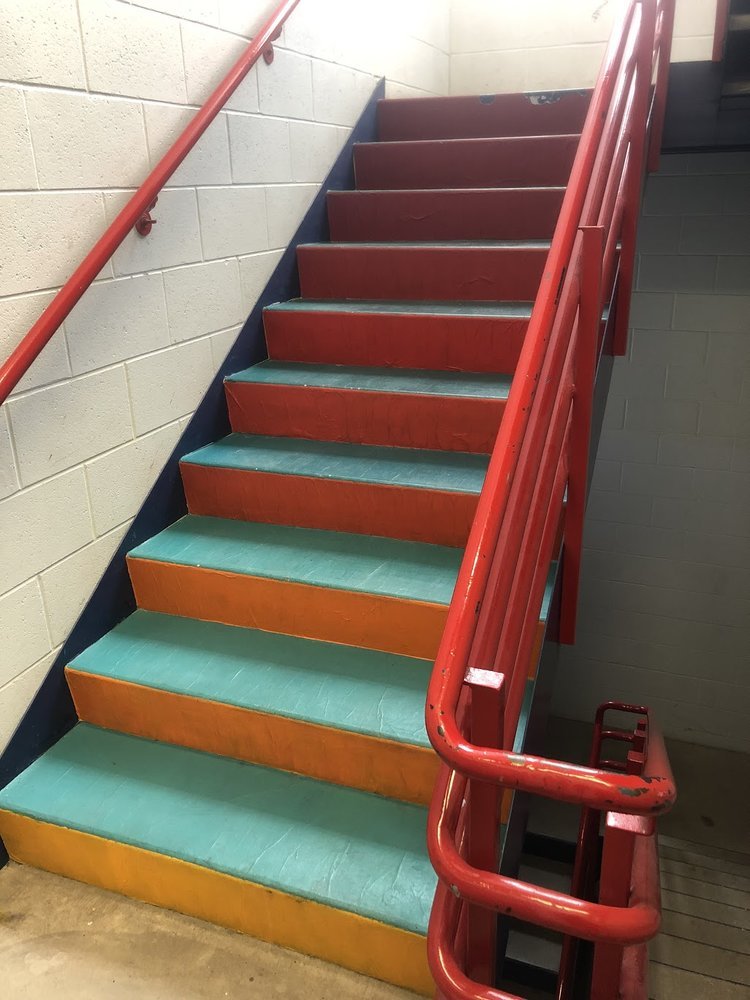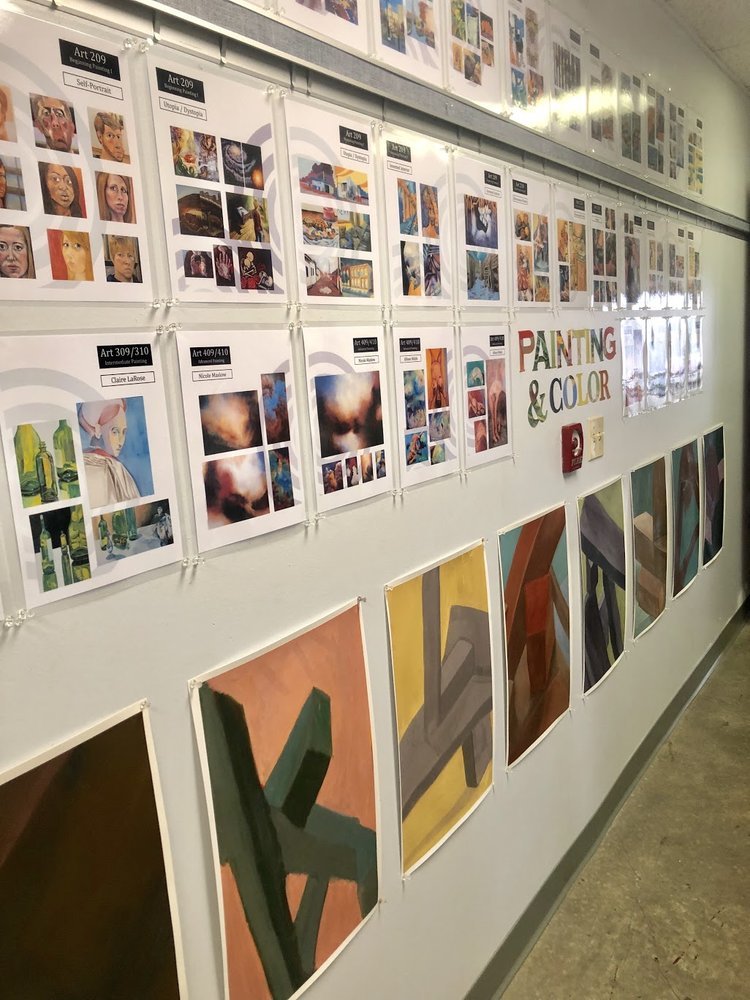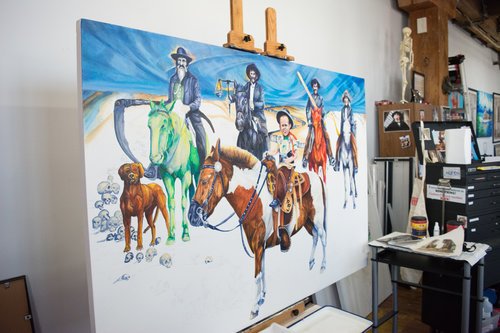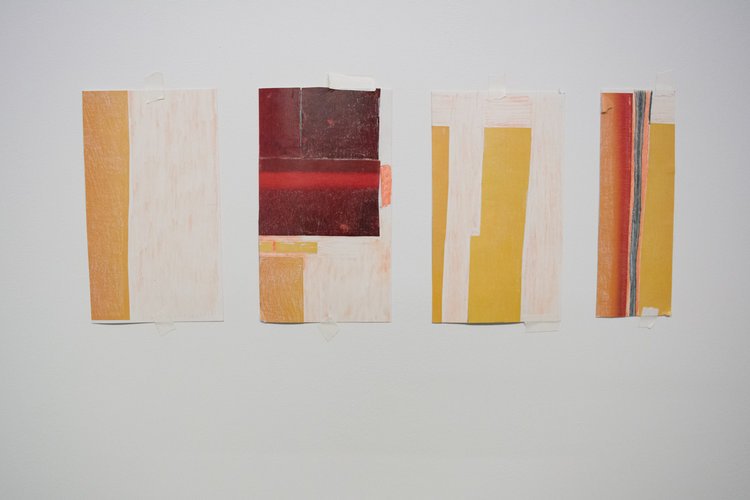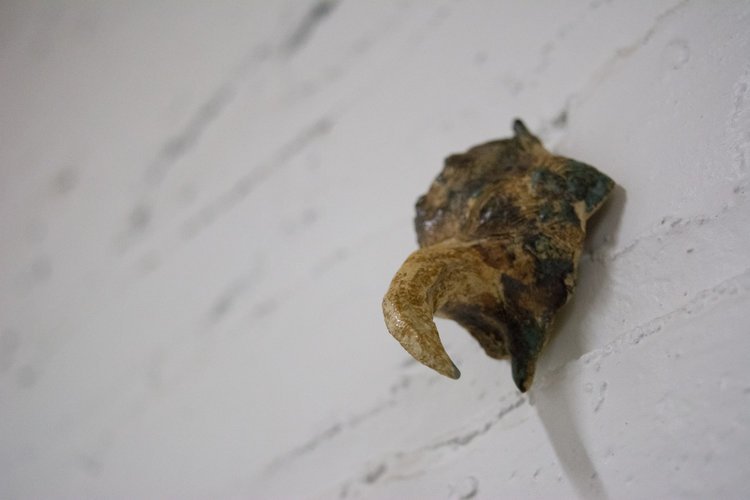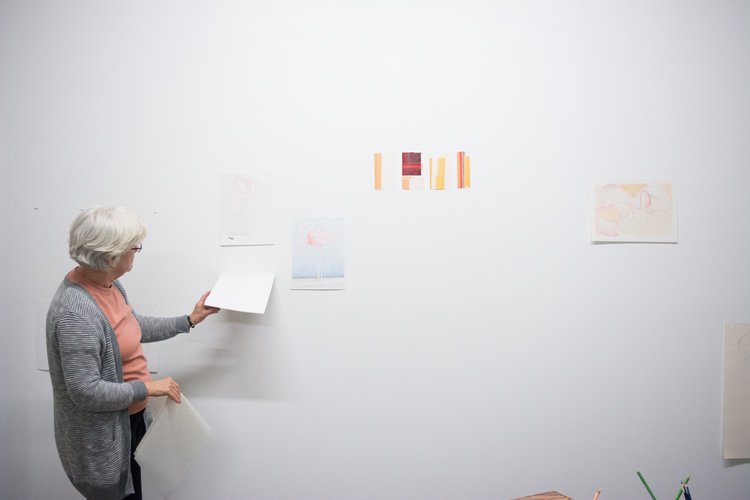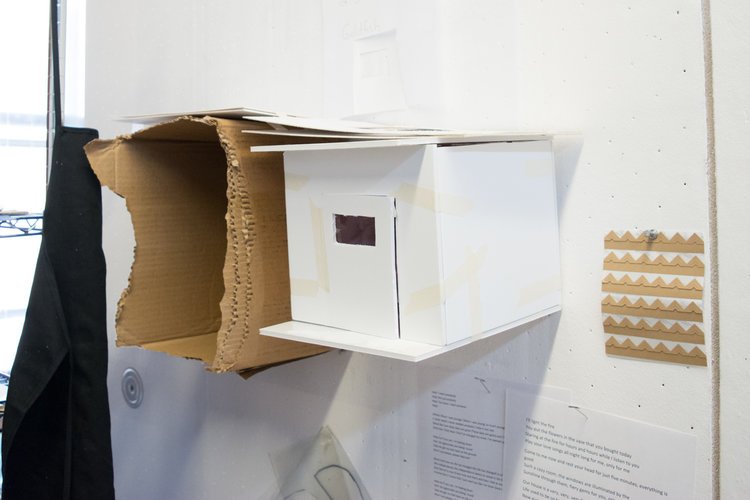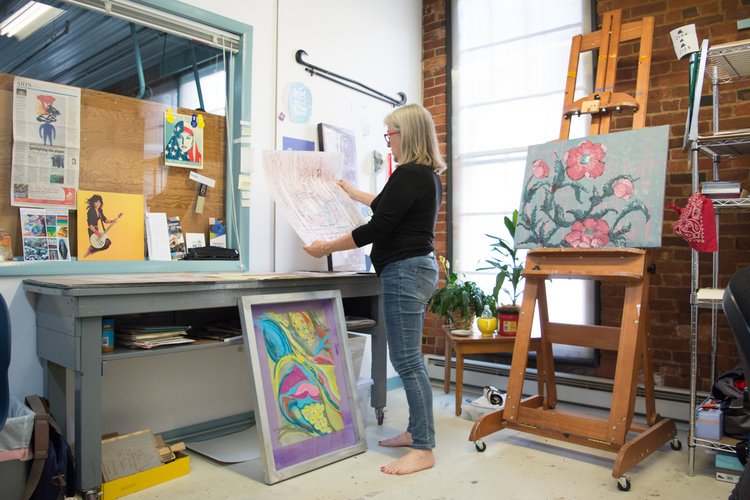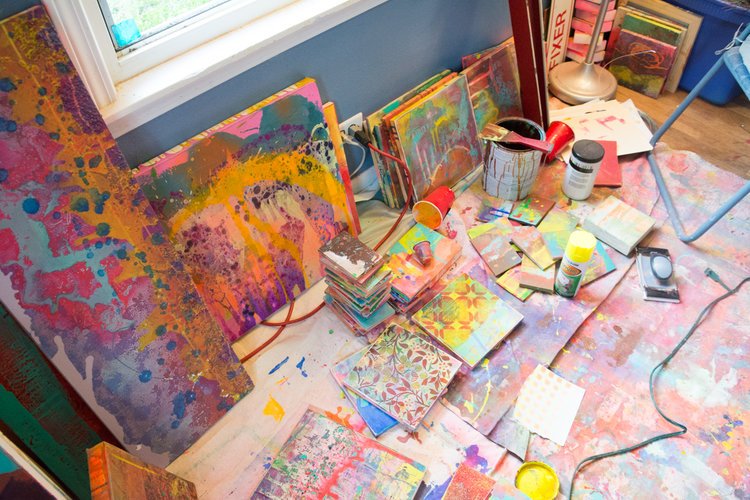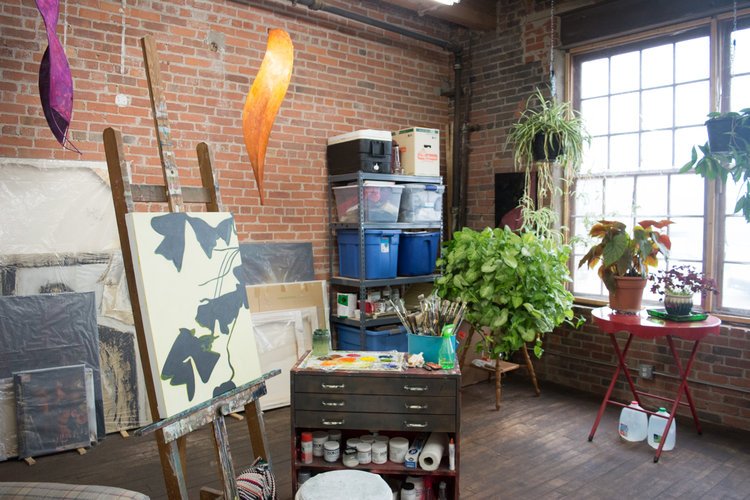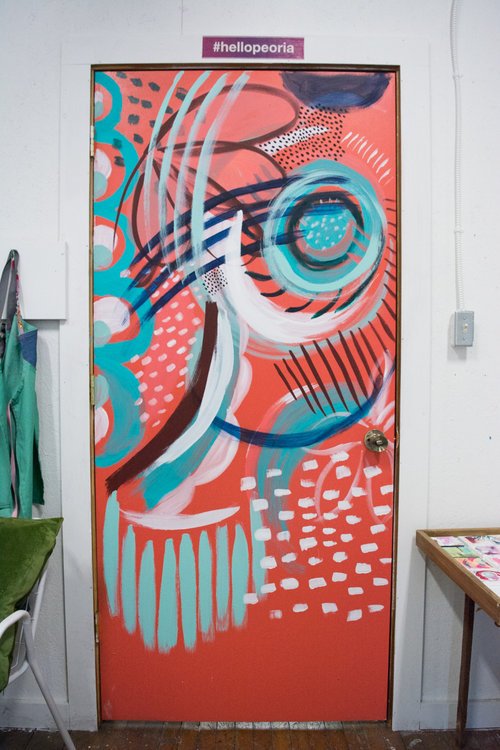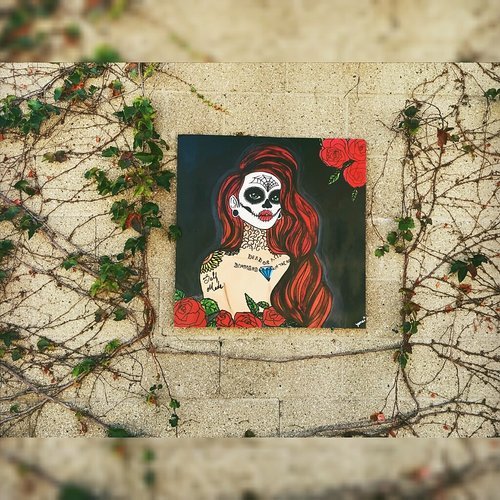ZW is an artist working in Bloomington-Normal, IL. More of his work can be found on here.
Project 1612: How would you describe the work you make?
ZW: I’m really interested in the intersection of worldbuilding and music. This intersection results in the work I make taking a number of forms. On my website, I brand myself to potential collaborators as a composer for screens, stages, and spaces and I think that most succinctly quantifies my output. But, what does that look like, right? For the commercial work I do (podcasts, games, films, videos, etc.) the application is really obvious: I’m working with a team to support their narrative and help realize the world they’re trying to create through music. My work for the stage is largely the same thing. I’m working with directors and dancers to tell the stories they want to tell.
My composition work for spaces is the most broadly defined area of my practice. It’s also the category where the project I’m bringing to Project 1612, Climate Changes! (Peoria), started so it’s probably the space worth talking about the most for this interview. The work that I make in this category is about using sound and music as a mediating force within our relationship to various environments and how that mediating relationship can be leveraged. In my practice and research, I divide “the environment” in a broad sense into two interconnected halves – the physical and the virtual. I am interested in how our various digital sonic realities inform our relationship and understanding of our physical sonic realities and vice versa. Climate Changes!, as a project, exists squarely on the physical side of the equation. It’s an experiment to see if a community can raise its awareness of its own sonic environment if given the freedom to take ownership of the sounds around them.
Project 1612: It is my understanding that you arrived at the idea of being an artist, in the traditional sense of the word, later than some other people we have talked to. You are first and foremost a composer, but when did you start to consider yourself a visual artist?
ZW: It’s true. The contemporary art world wasn’t even on my radar two years ago. It’s been a bit of a wild ride. When I began grad school in January 2018, Aaron Paolucci, the director of my program asked me to apply for the open graduate assistant position at University Galleries – something I was actually hesitant to do at first! He was aware that I’m a composer, but he thought I would be a good fit for the job regardless. I’m thankful for his foresight.
Fast forward to that following March, Jason Judd (former University Galleries curator and current Executive Director of New Genres Art Space) encouraged me to enter something into the upcoming Student Annual exhibition. I had never made anything remotely close to studio art before, but after spending my first three months on the job learning about the breadth and depth of the contemporary art world, I became interested in how I could activate the gallery space through my work. Plus, it was up to the jurors if I made it into the exhibition or not so there was no need for me to self-gatekeep and not enter just because a lack of experience on this side of the fine arts.
The resulting artwork, A Good Education (Explorations in Data and Music), was not only juried in but also won the awards for “Best in Digital/Interactive Media” and “Best in Show.” I was completely floored. I spent a lot of time worrying if the work would make it in — never did I expect to win anything. Winning both of those awards provided to me a lot encouragement. What surprised me the most was that there was a genuine interest in the work that I was creating in this space. It also showed me that the membrane dividing music and contemporary art was really porous at best. So with my newfound confidence in this space, I applied for my first residency that following summer with the Springfield Art Association which was really informative for me as well. The SAA has a really extensive art library and I spent a lot of time last July reading up on dada, surrealism, and new media. And in fact, the work that I created for my end-of-residency installation, faith comes by hearing, is in many ways the progenitor of Climate Changes!. Not long after returning home, Project 1612 put out its call for submissions and now here we are.
Project 1612: You are currently a M.S. Arts Technology candidate at Illinois State University (ISU). This might be unfamiliar territory for some, so can you describe what that program entails and what made you decide to study Arts Tech?
ZW: Absolutely! It’s funny; people often assume I’m an MFA candidate because of my association with University Galleries but, as you stated, that’s not the case. The Arts Technology program at ISU has been a total fulcrum in my life. It’s an incredibly forward-thinking program that focuses on the intersection of the fine arts, technology, and contemporary digital practices. I began the program as an undergrad and the big focus of the Arts Tech B.S./B.A. is enabling digital creatives to be literate in a number of disciplines (like web design, graphic design, sound design, creative coding, video production, and music production) and, once that foundation is in place, students are encouraged to go deep into their particular area of specialization. It’s probably this exact multidisciplinary literacy that helped me get hired on at University Galleries in the first place.
The Arts Tech M.S. is focused on the research and practice goals of each individual student. It’s a diverse group of students; some come with a strong tech background and others with a strong arts background. What has been nice for me is that, as somebody who went through the Arts Tech undergrad as well, I already exist in the kind of ecosystem that the program fosters and that’s really allowed me to stretch out. I’m currently conducting research for my thesis. It’s a really exciting time overall for me and the program because I’m the first student to do so. The program is focused on portfolio development but I’m strongly considering pursuing a PhD, so I chose to write a thesis alongside developing my portfolio.
I chose the program for the reasons I stated above: it’s forward-thinking. There is such a strong “yes, and” mentality in Arts Tech that I really value. Nothing is looked down upon, nothing is off-limits, and nothing is considered too hard. That freedom to experiment was really compelling to me and still remains so to this day.
Project 1612: As the current graduate assistant at University Galleries of ISU, how has working in a gallery setting changed your practice?
ZW: Other than being the incubator for my practice as it exists now, University Galleries has really been a space of tremendous growth and education for me. I think it’s important for me to recognize and give praise to the fact that University Galleries as an institution is world-class in the work that it presents and publishes but completely open to the community and student body they serve. I’m not sure if many people understand the tightrope act that really is. University Galleries has an incredible, 30+ years track record of important exhibitions and publications. Our 1990 and 1991 exhibitions David Wojnarowicz: Tongues of Flame and Keith Haring: Future Primeval were some of the first major surveys of either artist and some of our recent exhibitions like Strange Oscillations and Vibrations of Sympathy and Bethany Collins: A Pattern or Practice are of such significance to the historical moments we’re experiencing right now. Even in the short time that I’ve been with University Galleries, we’ve exhibited Ebony G. Patterson, Basim Magdy, william cordova, and Cecil McDonald, Jr. – all of whom are incredibly important.
I say all of this to illustrate the point I’m trying to make. This institution could be picky. Really, really picky. It could get away with any gatekeeping it wanted to and could set any sort of arbitrary standards that it wanted to. With University Galleries stellar track record, if it were a more typical institution, I question if I would’ve been selected to be the graduate assistant. I have never been art world material in any sort of traditional sense and without an institution available to me like University Galleries that so fully believes in its mission of serving its students and community, I wouldn’t be where I’m at today. I do a job for this institution but it’s doing so much more for me. In many ways, University Galleries feels like it shares a number of the ethos that the Arts Technology program espouses and that’s probably why I’m drawn so heavily to both. There is a students-first, forward-thinking mentality to both. It was incredibly forward-thinking for University Galleries to exhibit David Wojnarowicz and Keith Haring to a downstate university audience in the early 90s. Strange Oscillations opened a week before our caustic 2016 presidential election and predates the viral 2017 explosion of the Me Too movement by a year.
What has been so lucky for me is that my formative experiences with contemporary art have been in THIS space. This idea of creating, curating, and exhibiting work that’s facing forward in service of a community resonates very deeply with me.
Project 1612: What artists and composers have influenced your practice?
ZW: Right now, I’m really drawn to composers R. Murray Schafer and John Levack Drever for their work in sound studies. Schafer is the father of acoustic ecology, an artistic discipline that informs much of the work I’ll be doing in Peoria next month. Drever is a Professor at Goldsmiths University in London and the author of a paper on ethnography and soundscape composition that has been really foundational for me. I’m also influenced by the many artist-composer hybrids that have existed. This includes important historical figures like John Cage (who is practically the father of people like me) but also contemporary practitioners like Alejandro T. Acierto, Janet Cardiff, and Ally Mobbs.
My biggest composition influences are a trio of Japanese composers: Shoji Meguro, Yoko Shimomura, and Yoko Kanno. Meguro’s and Shimomura’s video game soundtracks have been instrumental to my development. Meguro’s fantastic j-pop, jazz fusion work for the Persona series is a masterclass in style and Shimomura’s gut-wrenching soundtrack to Final Fantasy XV, particularly the main theme Somnus, has reinvigorated my interest in orchestral textures. Kanno’s soundtrack to Cowboy Bebop was an early foundational influence on my personal musical aesthetic. Come to think of it, all three are really well known for their work scoring visual media and so it doesn’t really surprise me one bit that I have this growing personal interest in the relationship between visual art and music.
I’m also growing really interested in the Vaporwave scene. It’s a fascinating genre of music that recontextualizes the sounds and aesthetics of the 1980s and 90s through the lens of ironic nostalgia. The genre is rapidly expanding to include fascinating work focused on total left field topics like the weather channel and the sound of malls. Much of the music is anchored in a nostalgic relationship the composers have to the sonic environments of the past. I’ve been doing a lot of research contextualizing this music in the terms of soundscape composition and it’s been really satisfying.
Project 1612: Your upcoming Project 1612 exhibition has a collaborative component to it. Can you talk a little about that aspect of the exhibition? And is that typical of your work?
ZW: Climate Changes! as a project is almost entirely collaborative in nature – and it really excites me. The bigger picture goal of the project is to create a greater feeling of autonomy within the communities that participate and through that participation to generate a dictionary of terms for the sounds shared amongst that community. This collaborative, participatory element is central. I will go around recording sounds in Peoria and assemble them into a soundscape composition – and that’s largely where my direct involvement will end. What will make the exhibition special is that anybody in attendance will be invited to name any of the sounds they hear by writing the name on a piece of sheet music and pinning it to the wall. My hope is, that with everybody’s participation, the exhibition space will be blanketed in this new language that will emerge from a collective exercise in active listening.
I’ve grown to really enjoy collaboration as a form of aleatoricism. It’s been present in my work in some form or another for some time now. Some of the music I composed for A Good Education (Explorations in Data and Music) required a lot of participation from the musicians I worked with. But this project is the greatest amount of collaboration and community involvement I’ve incorporated yet and I’m really looking forward to it.
Project 1612: Do you have anything else coming up we should know about?
ZW: This August, at University Galleries, I’ll be curating my first exhibition. All My Friends Are In The Cloud is an exhibition of work by artist and filmmaker Jonah King. I’m collaborating with Jonah and a team of incredible grad students to exhibit an expanded version of his 2017 piece by the same name.
I’ve been really excited by this project. It feels like another crazy arc in the trajectory I’m on. Going from my introduction to the contemporary art world to curating my first exhibition within the space all in a span of 18 months is a little wild. But, once again, as with every other part of my story so far, it’s imperative that I point everything back to the people who enabled me in the first place. University Galleries Director and Chief Curator Kendra Paitz has been such an important mentor and friend to me during my time at University Galleries and it was with her permission, encouragement, guidance, and help that this exhibition will come to fruition.
So, please venture out to University Galleries this August and say hello.
Project 1612: What advice do you have for aspiring artists?
ZW: I have two pieces of advice to offer and I’ll explain both. One is to smash every gate that you come across. The second is don’t be a dick and always show up.
My first piece of advice is in regard to gatekeeping. I am of the mind that it causes more problems than it does create solutions. The trouble is, I think the fine arts can suffer greatly from this disease and so it is important for every practitioner to commit to smashing the gates they come across. They exist in two forms: internal and external gates. The external factor can be fixed if we choose to collectively operate from a place of abundance. There is enough to go around for everybody to have a piece and get their needs met. Artists working in one area of the arts do not need to fool themselves into being threatened by artists working in other areas – it’s reactionary and unhelpful. I mean, the name “fine arts” itself is pretty reactionary. How is it not a title drawn from some guarded elitism that stakes the claim “my art is better than yours”? It delays progress, really. Photography and film both had an uphill battle to acceptance because of gatekeeping. It’s 2019 and people still obnoxiously challenge if interactive art is art or not and act as if they’re generating helpful discourse. I say this all not as a rant but more as a plead to artists already established and those that are coming up to adopt a mindset of abundance. To be fearless in the face of new mediums. To assume the best in the work of others. Contemporary art has the wonderful tools of curation and critique at its disposal that do more to foster lovely work – art full of ideas, meaning, and emotion – than gatekeeping which only exists to keep out what challenges that which threatens what is within. It’s the idea of pulling people up instead of pushing people down.
But I think the greater threat to artists is internal gatekeeping. We all seem to have the tendency to do things that stop us from getting what we want. For example, a lot of artists use the term “aspiring artist” to describe themselves long after its appropriate. My advice to all aspiring artists is the moment after you create your first work of art, stop calling yourself aspiring. The reason I say that is because nobody wants to work with aspiring artists when they can just work with artists. By calling yourself “aspiring” after you’ve already created work, it reads as a lack of confidence and an inability to work professionally. Just call yourself an artist, even if you don’t think you’re ready to yet. Take yourself seriously so that you can provide the space for others to as well. You’ll be dealing with imposter syndrome for the rest of your career so it’s best not to give it a foothold early on.
My second piece of advice means exactly what it says: don’t be a dick and always show up. This has been my personal philosophy for success for years now and it has rarely failed. People want to work with: a.) people that are fun to be around and b.) people they can count on. If I follow these two commandments it gets me into the doors I want long before my skills are ever considered about 90% of the time. The art world, like any other community, is incredibly small. People will remember if they could count on you and people will remember if you were a joy to be around.
Project 1612: What are your thoughts on the art community in Central IL?
ZW: Coming into art by way of music, I was very happy to see that the Central IL art community shares the same DIY ethos as the music scene. Going beyond that, it’s easy to see that the DIY art community is very connected to the institutional art community in big ways: the collaboration between UIS and Springfield Art Association on DEMO Project, University Galleries Director and Chief Curator Kendra Paitz and her project space Violet Poe, McLean County Art Center’s recent hosting of pt.fwd, and of course Project 1612’s Jessica Bingham who has been a part of the art community at Bradley University, ICC, and now University Galleries. There are also so many institutional spaces and independent spaces as well. But I think this institutional and independent overlap is really telling of the size and vibrancy of the Central IL art community. There is so much incredible art being made and so many incredible conversations being had that there is this seeming need to continue to expand and create more space for everybody to participate. It also shows how interwoven the community is. Everybody is involved with everything to some extent and everything is happening everywhere to some extent.
I think overall there is a remarkably rich dialogue happening in Central IL that is being noticed in communities outside of our region that is generating a lot of interest. What I love the most is that our whole local ethos seems to emanate from a place of abundance.
